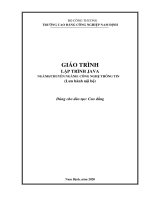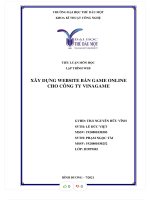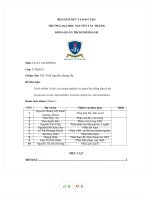a0010 java advanced 3d game programming with directx morebook vn 4058 2
Bạn đang xem bản rút gọn của tài liệu. Xem và tải ngay bản đầy đủ của tài liệu tại đây (179.41 KB, 7 trang )
Advanced 3D Game Programming with DirectX 9.0
by Peter Walsh
ISBN:1556229682
Wordware Publishing © 2003 (525 pages)
Designed for programmers who are new to graphics and game programming, this book covers Direct 3D,
DirectInput, and DirectSound, as well as artificial intelligence, networking, multithreading, and scene
management.
Companion Web Site
Table of Contents
Advanced 3D Game Programming Using DirectX 9.0
Introduction
Chapter 1
- Windows
Chapter 2
- Getting Started with DirectX
Chapter 3
- Communicating with DirectInput
Chapter 4
- DirectSound
Chapter 5
- 3D Math Foundations
Chapter 6
- Artificial Intelligence
Chapter 7
- UDP Networking
Chapter 8
- Beginning Direct3D
Chapter 9
- Advanced 3D Programming
Chapter 10 - Advanced Direct3D
Chapter 11 - Scene Management
Appendix
- An STL Primer
Index
List of Figures
List of Tables
List of Code Examples
Advanced 3D Game Programming
Using DirectX 9.0
Peter Walsh
1
Wordware Publishing, Inc.
Library of Congress Cataloging-in-Publication Data
Walsh, Peter (Peter Andrew), 1980Advanced 3D game programming with DirectX 9.0 / by Peter Walsh.
p. cm.
ISBN 1-55622-968-2 (pbk.)
1. Computer games–Programming. 2. DirectX. I. Title.
QA76.76.C672W382 2003
794.8'167768–dc21 2003007140
CIP
Copyright © 2003 Wordware Publishing, Inc.
All Rights Reserved
2320 Los Rios Boulevard
Plano, Texas 75074
No part of this book may be reproduced in any form or by any means without permission in writing from
Wordware Publishing, Inc.
1-55622-968-2
10 9 8 7 6 5 4 3 2 1
0403
DirectX is a registered trademark of Microsoft Corporation in the United States and/or other countries.
All brand names and product names mentioned in this book are trademarks or service marks of their
respective companies. Any omission or misuse (of any kind) of service marks or trademarks should not
be regarded as intent to infringe on the property of others. The publisher recognizes and respects all
marks used by companies, manufacturers, and developers as a means to distinguish their products.
All inquiries for volume purchases of this book should be addressed to Wordware Publishing, Inc., at the
above address. Telephone inquiries may be made by calling:
(972) 423-0090
Dedications
To my beautiful fiancée Lisa Sullivan
I love you with all my heart.
Peter
To my parents, Manny and Maria
2
Adrian
Original edition for DirectX version 7.0 written by Adrian Perez with Dan Royer. Revised and updated by
Peter Walsh.
Acknowledgments
Like Adrian says below, this book, like any other, was not just the work of one (or two or three) people;
there have been so many people over the years who have helped me in one way or another, and the
result of all these efforts contributed to the knowledge contained in this book. I will try to thank everyone
I can. My update of this book would not have occurred without the help of Tracy Williams, who has
helped me many times with my books. Not only did she get me going on my first book, but she got me
hooked up with Wordware for this book, my third. Of course, I must thank Jim Hill, Wes Beckwith, and
Tim McEvoy of Wordware for being such great people to work with.
Thanks to Phil Taylor on the DirectX team at Microsoft for agreeing to do the tech check and also to
Wolfgang Engel and Bruno Sousa for their technical support. Of course, thank you to my wonderful
fiancee Lisa for helping to keep me motivated while working on the book, when I just wanted to give up
and party!
Where would I be without thanking all my friends and family, who keep me sane during the many
months that I spent researching and writing these massive books. So thank you Jon-Paul Keatley,
Stewart Wright, Andrew McCall, Todd Fay, Mike Andrews, Laz Allen, and all my other friends around
the world that I don't have room to list! Also, who would I be writing a book and not mentioning my soonto-be family-in-law? So thank you Liam and Ann Sullivan for giving me permission to marry your
beautiful daughter (also to Joanne, Pauline, Liam Jr., and the rest of the family). Of course, thanks to
my parents Simon and Joy Walsh for being so supportive during my younger years and to this day.
The worst thing about writing acknowledgments is that you always forget someone who helped you until
the day the book goes to print. So thank you to everyone else I forgot—please accept my apologies; my
poor brain is worn out after all this work!
Peter Walsh
This book couldn't have been completed without the help and guidance of a whole lot of people. I'll try to
remember them all here. First, thanks to Wes Beckwith and Jim Hill at Wordware Publishing. They were
extremely forgiving of my hectic schedule, and they helped guide me to finishing this book. I also must
thank Alex Dunne for letting me write an article in 1998 for Game Developer magazine. If I hadn't written
that article, I never would have written this book.
Everything I know about the topics in this book I learned from other people. Some of these people were
mentors, others were bosses, and still others were professors and teachers. Some were just cool
people who took the time to sit and talk with me. I can't thank them enough. Paul Heckbert, Tom
3
Funkhouser, Eric Petajan, Charles Boyd, Mike Toelle, Kent Griffin, David Baraff, Randy Pausch, Howie
Choset, Michael Abrash, Hugues Hoppe, and Mark Stehlik: You guys rock. Thank you.
Thanks to Microsoft, ATI, nVidia, id Software, and Lydia Choy for helping me with some of the images
used in the text.
Many people helped assure the technical correctness and general sanity of this text. Ian Parberry and
his class at University of North Texas were immensely helpful: Thanks, guys. Michael Krause was an
indispensable help in assuring the correctness of the DirectX chapters. Bob Gaines, Mikey Wetzel, and
Jason Sandlin from the DirectX team at Microsoft helped make sure Chapters 2, 3, 4, 8, and 10 were
shipshape: Mad props to them. David Black was kind enough to look over Chapter 11 and help remove
some errors and clarify a few points.
Finally, I need to thank all of the people who helped me get this thing done. I know I won't be able to
remember all of them, but here's a short list: Manual and Maria Perez, Katherin Peperzak, Lydia Choy
(again), Mike Schuresko, Mike Breen (and the rest of the Originals), Vick Mukherjee, Patrick Nelson,
Brian Sharp, and Marcin Krieger.
Adrian Perez
About the author
Peter Walsh is a professional game programmer at Visual Science Ltd., where he has worked on a
number of titles including the Formula 1 series of games, Harry Potter and the Chamber of Secrets, and
others for Electronic Arts, the world's leading publisher of computer games. He has studied for a degree
in computer games development at Abertay University in Dundee, Scotland, and has worked with ICCAVE, a think tank for the next generation of gaming technology.
The complete source code in C++, including a game demonstrating techniques covered in this book,
can be downloaded from />
Introduction
A wise man somewhere, somehow, at some point in history, may have said the best way to start a book
is with an anecdote. I would never question the words of a wise man who may or may not have existed,
so here we go.
When I was a freshman in high school back in 1993, I took the required biology class that most kids my
age end up having to take. It involved experiments, lab reports, dissecting of various animals, and the
like. One of my lab partners was a fellow named Chris V. We were both interested in computers and
quickly became friends, to the point where talking about biology in class was second to techno-babble.
4
One night, in the middle of December, Chris called me up. The lab report that was due the next day
required results from the experiment we had done together in class, and he had lost his copy of our
experiment results. He wanted to know if I could copy mine and bring them over to his place so he could
finish writing up the lab. Of course, this was in those heinous pre-car days, so driving to his house
required talking my parents into it, finding his address, and various other hardships. While I was willing
to do him the favor, I wasn't willing to do it for free. So I asked him what he could do to reciprocate my
kind gesture.
"Well," he said, "I guess I can give you a copy of this game I just got."
"Really? What's it called?" I said.
"Doom. By the Wolf 3D guys." "It's called Doom? What kind of name is that??"
After getting the results to his house and the game to mine, I fired the program up on my creaky old 386
DX-20 clone, burning rubber with a whopping 4 MB of RAM. As my space marine took his first tenuous
steps down the corridors infested with hellspawn, my life changed. I had done some programming
before in school (Logo and Basic), but after I finished playing the first time, I had a clear picture in my
head of what I wanted to do with my life: I wanted to write games, something like Doom. I popped onto a
few local bulletinboards and asked two questions: What language was the game written in, and what
compiler was used?
Within a day or so, I purchased Watcom C 10.0 and got my first book on C programming. My first C
program was "Hello, World." My second was a slow, crash-happy, non-robust, wireframe spinning cube.
I tip my hat to John Carmack, John Romero, and the rest of the team behind Doom; my love for creating
games was fully realized via their masterpiece. It's because of them that I learned everything that I have
about this exceptionally interesting and dynamic area of computer acquired programming. The
knowledge that I have is what I hope to fill these pages with, so other people can get into graphics and
game programming.
I've found that the best way to get a lot of useful information down in a short amount of space is to use
the tried-and-true FAQ (frequently asked questions) format. I figured if people needed answers to some
questions about this book as they stood in their local bookstore trying to decide whether or not to buy it,
these would be them.
Who are you? What are you doing here?
Well I, being Peter rather than Adrian, am a professional games programmer and have been for a quite
a few years. I started out like most people these days, getting extremely interested in how games
worked after Doom came out. After teaching myself programming, I moved on to study for a degree in
computer games development at Abertay University in Dundee, Scotland. After that I went on to work
for a short while with IC-CAVE, which is a think tank for the next generation of gaming technology. Over
5
Example 9.2: Snippets from InvKim
Example 9.3: The cSlowBezierIterator class
Example 9.4: Forward difference iterator class
Example 9.5: Sample code to draw a Bezier curve
Example 9.6: Notable code from the teapot program
Example 9.7: B-spline calculation code
Example 9.8: Vertex, edge, and triangle structures
Example 9.9: The code to handle subdivision
Example 9.10: Sample edge collapse structure
Example 9.11: Pseudocode for the radiosity algorithm
Example 9.12: Sample from the radiosity data file
Example 9.13: Snippets from the radiosity calculator
Chapter 10: Advanced Direct3D
Example 10.1: Enabling alpha blending
Example 10.2: Texture.h
Example 10.3: Texture.cpp
Example 10.4: Sample code for setting up light mapping using multitexture
Example 10.5: Sample code for setting up light mapping using multipass
Example 10.6: Activating cubic environment mapping
Example 10.7: Sample code for setting up detail mapping using multitexture
Example 10.8: Sample code for setting up detail mapping using multipass
Example 10.9: Device checking code for the Detail sample
Example 10.10: Sample code for setting up glow mapping using multitexture
Example 10.11: Sample code for setting up glow mapping using multipass
Example 10.12: Sample code for setting up gloss mapping
705
Example 10.13: Code to draw the base pass
Example 10.14: Code to draw the detail pass
Example 10.15: Code to draw the glow pass
Example 10.16: Code to do environment mapping
Example 10.17: Code to draw the gloss pass
Example 10.18: Code to draw the cloud pass
Example 10.19: Device confirmation code
Example 10.20: Sample code to set up the stencil buffer for an overdraw counter
Example 10.21: Sample code to set up the stencil buffer for a wipe
Chapter 11: Scene Management
Example 11.1: ViewCone.h
Example 11.2: ViewCone.cpp
Example 11.3: Pseudocode for exact portal rendering
Example 11.4: The iGameObject interface
Example 11.5: objID code
Example 11.6: Pseudocode for exact portal rendering
Example 11.7: Code for the message daemon
Example 11.8: Code for the cNetMessage class
Appendix: An STL Primer
Example A.1: Non-template code
Example A.2: Template code
Example A.3: Template sample code
Example A.4: Using iterators
Example A.5: A cleaned-up version of for_each
706









